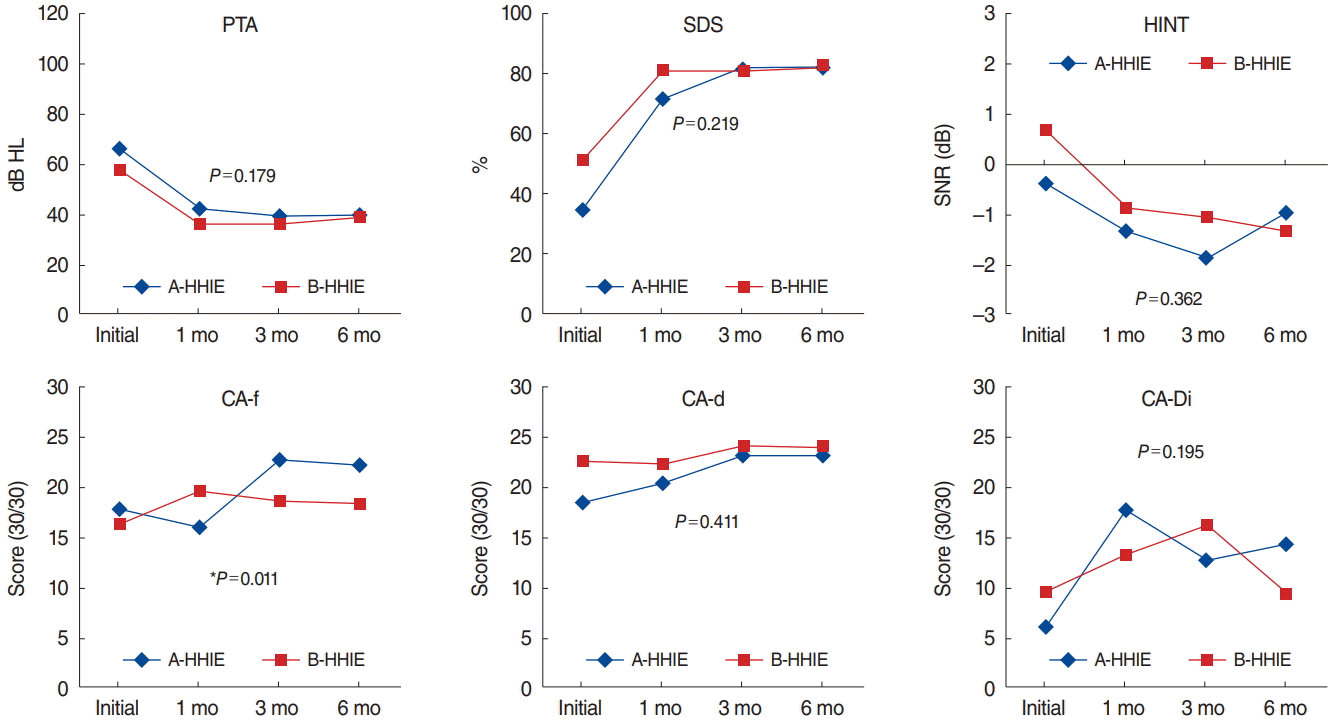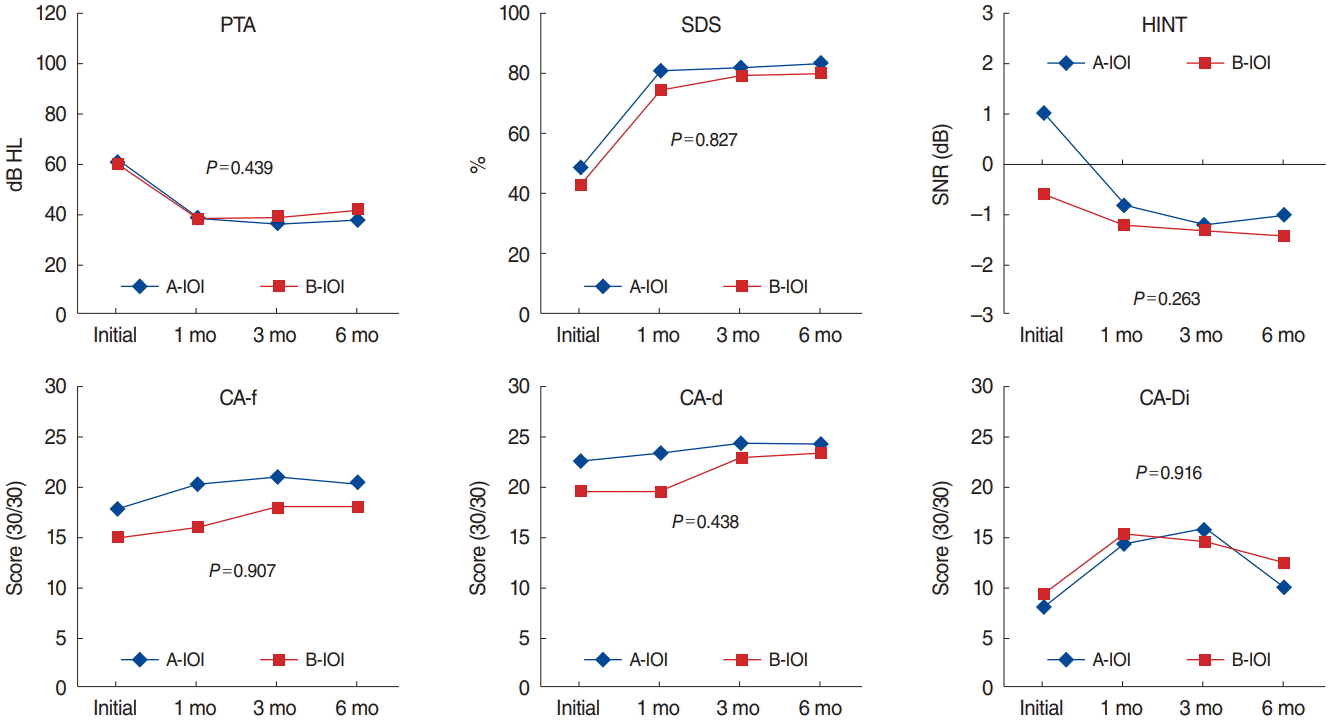1. Schoevers RA, Beekman AT, Deeg DJ, Geerlings MI, Jonker C, Van Tilburg W. Risk factors for depression in later life; results of a prospective community based study (AMSTEL). J Affect Disord. 2000; Aug. 59(2):127–37.

2. Gopinath B, Hickson L, Schneider J, McMahon CM, Burlutsky G, Leeder SR, et al. Hearing-impaired adults are at increased risk of experiencing emotional distress and social engagement restrictions five years later. Age Ageing. 2012; Sep. 41(5):618–23.

3. Mulrow CD, Aguilar C, Endicott JE, Tuley MR, Velez R, Charlip WS, et al. Quality-of-life changes and hearing impairment: a randomized trial. Ann Intern Med. 1990; Aug. 113(3):188–94.
4. Weinstein BE. Treatment efficacy: hearing aids in the management of hearing loss in adults. J Speech Hear Res. 1996; Oct. 39(5):S37–45.
5. Chien W, Lin FR. Prevalence of hearing aid use among older adults in the United States. Arch Intern Med. 2012; Feb. 172(3):292–3.

6. Moon IJ, Baek SY, Cho YS. Hearing aid use and associated factors in South Korea. Medicine (Baltimore). 2015; Oct. 94(42):e1580.

7. Roth TN, Hanebuth D, Probst R. Prevalence of age-related hearing loss in Europe: a review. Eur Arch Otorhinolaryngol. 2011; Aug. 268(8):1101–7.

8. Kahveci OK, Miman MC, Okur E, Aycicek A, Sevinc S, Altuntas A. Hearing aid use and patient satisfaction. Kulak Burun Bogaz Ihtis Derg. 2011; May-Jun. 21(3):117–21.

9. Smeeth L, Fletcher AE, Ng ES, Stirling S, Nunes M, Breeze E, et al. Reduced hearing, ownership, and use of hearing aids in elderly people in the UK--the MRC Trial of the Assessment and Management of Older People in the Community: a cross-sectional survey. Lancet. 2002; Apr. 359(9316):1466–70.

10. Bertoli S, Staehelin K, Zemp E, Schindler C, Bodmer D, Probst R. Survey on hearing aid use and satisfaction in Switzerland and their determinants. Int J Audiol. 2009; Apr. 48(4):183–95.

11. Gianopoulos I, Stephens D, Davis A. Follow up of people fitted with hearing aids after adult hearing screening: the need for support after fitting. BMJ. 2002; Aug. 325(7362):471.

12. Hartley D, Rochtchina E, Newall P, Golding M, Mitchell P. Use of hearing AIDS and assistive listening devices in an older Australian population. J Am Acad Audiol. 2010; Nov-Dec. 21(10):642–53.

13. McCormack A, Fortnum H. Why do people fitted with hearing aids not wear them. Int J Audiol. 2013; May. 52(5):360–8.

14. Oh SH, Lee J. General framework of hearing aid fitting management. J Audiol Otol. 2016; Apr. 20(1):1–7.

15. Sardari S, Jafari Z, Haghani H, Talebi H. Hearing aid validation based on 40 Hz auditory steady-state response thresholds. Hear Res. 2015; Dec. 330(Pt A):134–41.
16. Wu YH, Bentler RA. Clinical measures of hearing aid directivity: assumption, accuracy, and reliability. Ear Hear. 2012; Jan-Feb. 33(1):44–56.

17. Gil D, Iorio MC. Formal auditory training in adult hearing aid users. Clinics (Sao Paulo). 2010; Feb. 65(2):165–74.

18. Ventry IM, Weinstein BE. The hearing handicap inventory for the elderly: a new tool. Ear Hear. 1982; May-Jun. 3(3):128–34.
19. Cox RM, Alexander GC. The international outcome inventory for hearing aids (IOI-HA): psychometric properties of the English version. Int J Audiol. 2002; Jan. 41(1):30–5.
20. Brannstrom KJ, Lantz J, Nielsen LH, Olsen SO. Prediction of IOI-HA scores using speech reception thresholds and speech discrimination scores in quiet. J Am Acad Audiol. 2014; Feb. 25(2):154–63.

21. Lee DH, Noh H. Prediction of the use of conventional hearing aids in Korean adults with unilateral hearing impairment. Int J Audiol. 2015; 54(9):613–9.

22. Chu H, Cho YS, Park SN, Byun JY, Shin JE, Han GC, et al. Standardization for a Korean adaptation of the international outcome inventory for hearing aids: study of validity and reliability. Korean J Otorhinolaryngol Head Neck Surg. 2012; 55(1):20–5.

23. Cox RM, Gilmore C, Alexander GC. Comparison of two questionnaires for patient-assessed hearing aid benefit. J Am Acad Audiol. 1991; Jul. 2(3):134–45.
24. Gatehouse S. Self-report outcome measures for adult hearing aid services: some uses, users, and options. Trends Amplif. 2001; Sep. 5(3):91–110.

25. Mendel LL. Objective and subjective hearing aid assessment outcomes. Am J Audiol. 2007; Dec. 16(2):118–29.

26. Humes LE, Halling D, Coughlin M. Reliability and stability of various hearing-aid outcome measures in a group of elderly hearing-aid wearers. J Speech Hear Res. 1996; Oct. 39(5):923–35.

27. Kim SY, Park JS, Kim MB. Clinical usefulness of speech mapping for fitting of hearing aids. Korean J Otorhinolaryngol Head Neck Surg. 2017; Oct. 61(6):287–94.







 PDF
PDF Citation
Citation Print
Print



 XML Download
XML Download